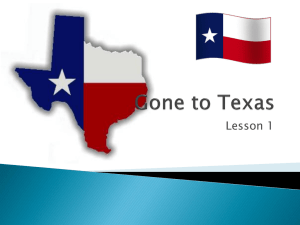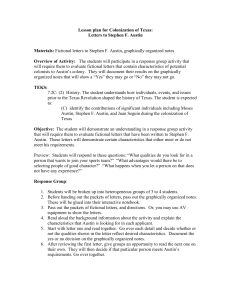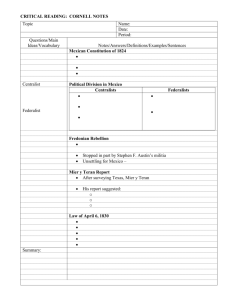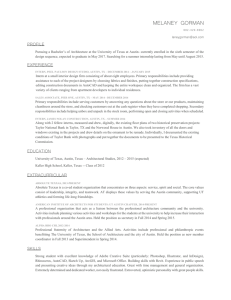Kinder_Compare Stephen F. Austin y George Washington
advertisement
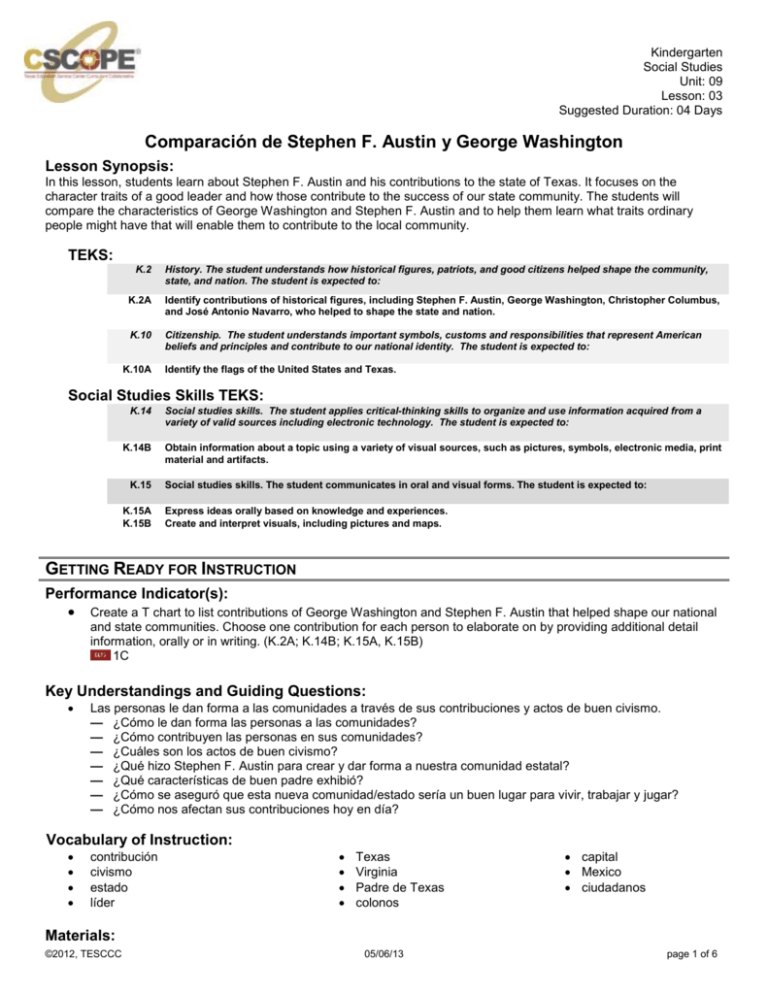
Kindergarten Social Studies Unit: 09 Lesson: 03 Suggested Duration: 04 Days Comparación de Stephen F. Austin y George Washington Lesson Synopsis: In this lesson, students learn about Stephen F. Austin and his contributions to the state of Texas. It focuses on the character traits of a good leader and how those contribute to the success of our state community. The students will compare the characteristics of George Washington and Stephen F. Austin and to help them learn what traits ordinary people might have that will enable them to contribute to the local community. TEKS: K.2 History. The student understands how historical figures, patriots, and good citizens helped shape the community, state, and nation. The student is expected to: K.2A Identify contributions of historical figures, including Stephen F. Austin, George Washington, Christopher Columbus, and José Antonio Navarro, who helped to shape the state and nation. K.10 Citizenship. The student understands important symbols, customs and responsibilities that represent American beliefs and principles and contribute to our national identity. The student is expected to: K.10A Identify the flags of the United States and Texas. Social Studies Skills TEKS: K.14 K.14B K.15 K.15A K.15B Social studies skills. The student applies critical-thinking skills to organize and use information acquired from a variety of valid sources including electronic technology. The student is expected to: Obtain information about a topic using a variety of visual sources, such as pictures, symbols, electronic media, print material and artifacts. Social studies skills. The student communicates in oral and visual forms. The student is expected to: Express ideas orally based on knowledge and experiences. Create and interpret visuals, including pictures and maps. GETTING READY FOR INSTRUCTION Performance Indicator(s): Create a T chart to list contributions of George Washington and Stephen F. Austin that helped shape our national and state communities. Choose one contribution for each person to elaborate on by providing additional detail information, orally or in writing. (K.2A; K.14B; K.15A, K.15B) 1C Key Understandings and Guiding Questions: Las personas le dan forma a las comunidades a través de sus contribuciones y actos de buen civismo. — ¿Cómo le dan forma las personas a las comunidades? — ¿Cómo contribuyen las personas en sus comunidades? — ¿Cuáles son los actos de buen civismo? — ¿Qué hizo Stephen F. Austin para crear y dar forma a nuestra comunidad estatal? — ¿Qué características de buen padre exhibió? — ¿Cómo se aseguró que esta nueva comunidad/estado sería un buen lugar para vivir, trabajar y jugar? — ¿Cómo nos afectan sus contribuciones hoy en día? Vocabulary of Instruction: contribución civismo estado líder Texas Virginia Padre de Texas colonos capital Mexico ciudadanos Materials: ©2012, TESCCC 05/06/13 page 1 of 6 Kindergarten Social Studies Unit: 09 Lesson: 03 Refer to Notes for Teacher section from materials. Attachments: Teacher Resource: PowerPoint: Stephen F. Austin: The Father of Texas Resources and References: None identified Advance Preparation: 1. Become familiar with content and procedures for the lesson, including the idea that Stephen F. Austin helped shape our state. 2. Refer to the Instructional Focus Document for specific content to include in the lesson. 3. Select appropriate sections of the textbook and other classroom materials that support the learning for this lesson. 4. Preview websites according to district guidelines. 5. Gather books about Stephen F. Austin. 6. Prepare materials and handouts as needed. Background Information: Authority Figures: Authority figures set standards, enforce the law, or maintain social order in the absence of laws. Most people respect authority and comply with the written or spoken rules. Authority figures include parents and grandparents, school teachers and principals, police officers, clergy, military officers, and others in positions of authority. Historical Figures: People associated with past happenings who achieve some notability are historical figures. Stephen F. Austin: (1793-1836) Stephen F. Austin is considered the “Father of Texas” due to his continued efforts to settle the territory. His father Moses Austin contracted with the Spanish government to colonize a portion of northern Mexico. When Moses died in June 1821, the contract transferred to the younger Austin. Stephen selected a site for his colony along the Brazos and Colorado rivers and began recruiting families in 1821. Progress was slow because of difficulty in transporting supplies into the area and because of changing Mexican politics. Austin frequently discussed the future of his colony with Mexican officials and he earned their trust. By 1825, 297 families lived in Austin’s Colony. They were called the “Old Three Hundred.” Austin continued to negotiate with the Mexican government and represent residents. He also secured other land grants. In ten years he helped more than 1,500 families settle in Texas. At first the leadership of Antonio López de Santa Anna pleased Austin, but as Santa Anna assumed more and more control, he limited the freedom of the Texans. Austin supported the organized opposition to the absolute power of Santa Anna. This opposition led to the Texas Revolution. Austin is remembered in Texas history for his many efforts on behalf of Texas before, during, and immediately after Texas' Revolution with Mexico. His contributions to Texas included: long and perilous pilgrimages to Mexico on behalf of Texas; his unwillingness to counsel his people to take up arms against the Mexican government as long as any hope for peace remained; his firm and decided voice, speaking words of encouragement and hope during the darkest days of the revolution; and his laborious travels in the United States to obtain needed support for his struggling countrymen. Flags of the United States Prior to 1777 the patriots fought under the Grand Union flag. In 1777, the Continental Congress approved a new flag with 13 stripes and 13 stars representing the 13 colonies. Each time a state entered the union one star and one stripe were added. In 1818, the U.S. Congress set the number of stripes at 13, but agreed to continue to add a star for each new state. Flags of Texas Six flags have flown over Texas. These represent the different nations which occupied Texas territory beginning with Spain, then France, Mexico, the Republic of Texas, the Confederate States of America, and the United States of America. The Republic adopted a flag on December 10, 1836, but later, in 1839, approved the Lone Star flag as the official flag of the Republic of Texas. When Texas became the twenty-eighth state in the United States in 1845, the flag of the United States was added, but the Lone Star flag remained the official state flag. The flag of the Confederacy flew from 1861 until June 1, 1865, at which time President Andrew Johnson announced that the state was readmitted to the Union and the flag of the United States of America replaced the flag of the Confederacy. Definitions and text courtesy of the Social Studies Center [defunct]. (2000). Glossary. Austin: Texas Education Agency. and ©2012, TESCCC 05/06/13 page 2 of 6 Kindergarten Social Studies Unit: 09 Lesson: 03 Social Studies Center [defunct]. (2000). Biographies. Austin: Texas Education Agency. GETTING READY FOR INSTRUCTION SUPPLEMENTAL PLANNING DOCUMENT Instructors are encouraged to supplement and substitute resources, materials, and activities to differentiate instruction to address the needs of learners. The Exemplar Lessons are one approach to teaching and reaching the Performance Indicators and Specificity in the Instructional Focus Document for this unit. Instructors are encouraged to create original lessons using the Content Creator in the Tools Tab located at the top of the page. All originally authored lessons can be saved in the “My CSCOPE” Tab within the “My Content” area. INSTRUCTIONAL PROCEDURES Instructional Procedures Notes for Teacher ENGAGE – Introduce the name “Austin” 1. Display a picture of Stephen F. Austin. Introduce him as a historical figure and explain how he was very important to Texas. NOTE: 1 Day = 30 minutes Suggested Day 1 ‒ 3 minutes Materials: Picture of Stephen F. Austin Picture of the Texas state capitol 2. Display a picture of the state capitol of Texas. Ask: Do you know where the state capitol of Texas is? (Austin, Texas is the location of our state capitol. It is named after Stephen F. Austin.) Purpose: To focus attention on the name “Austin.” EXPLORE – The story of Stephen F. Austin Suggested Day 1 (continued) ‒ 10 minutes 1. Share with students the story of Stephen F. Austin using the Teacher Resource: PowerPoint: Stephen F. Austin: The Father of Texas, or a picture book about Stephen F. Austin. The following points may be included: Stephen F. Austin was born in Virginia on November 3, 1793. Stephen F. Austin became a leader to the people who settled in Texas. Austin helped the colonists write rules for their new colony. Stephen F. Austin died on December 27, 1836, at the age of 43. After Stephen F. Austin died, the city of Austin, the capital of Texas, was named in honor of him. TEKS: K.2A; K.10A; K.14B; K.15A: K.15B Attachments: Teacher Resource: PowerPoint: Stephen F. Austin: The Father of Texas Purpose: Learn background information about the life of Stephen F. Austin and the role he played in the history of Texas. TEKS: K.2A; K.10A; K.14B; K.15A: K.15B EXPLAIN –Life of Stephen F. Austin Suggested Day 1 (continued) ‒ 17 minutes 1. Students share what they know about Stephen F. Austin with a partner. 2. Teacher monitors, listening to student statements and/or scribing. Purpose: Students explain what they know about the life of Stephen F. Austin. TEKS: K.2A; K.10A; K.14B; K.15A: K.15B ENGAGE – United States Flag 1. Display the United States Flag. Ask: • Who can identify the flag? • Who knows what the flag stands for and why we display the flag. 2. Encourage students to recall information about the flag from Celebrate Freedom Week in September. Emphasize that the United States flag is the flag for our nation. ©2012, TESCCC 05/06/13 Suggested Day 2 ‒ 5 minutes Materials: United States Flag Purpose: Focus on the United States Flag. TEKS: K.2A; K.10A; K.14B; K.15A: K.15B page 3 of 6 Kindergarten Social Studies Unit: 09 Lesson: 03 Instructional Procedures Notes for Teacher EXPLORE – Texas Flag Suggested Day 2 (continued) ‒ 15 minutes 1. 2. Display the Texas Flag. Students should be familiar with the Texas flag. 3. Ask: How is this flag different from the U.S. flag? Display both flags side by side. Students compare and contrast Purpose: Understand the Texas Flag is the state flag. TEKS: K.2A; K.10A; K.14B; K.15A: K.15B orally through a teacher guided discussion. EXPLAIN – Add Stephen F. Austin to timeline Suggested Day 2 (continued) ‒ 5 minutes ENGAGE – Leader of Our Country and Leader of Texas Suggested Day 3 ‒ 5 minutes Materials: Photos of George Washington and Stephen F. Austin 1. Display photos of George Washington and Stephen F. Austin. 2. Review the contributions made by George Washington through pictures, a PowerPoint or a story. Purpose: Focus on George Washington and Stephen F. Austin. TEKS: K.2A; K.10A; K.14B; K.15A: K.15B EXPLORE – Leader of Texas 1. Review with students the characteristics of a good leader. 2. Like George Washington, Stephen F. Austin exhibited these characteristics as he helped create and shape our state. 3. While emphasizing the role Stephen F. Austin played in shaping our state, include the following facts that led to his and earning the title “Father of Texas.” (Age appropriate comparisons to a father in parentheses.) Suggested Day 3 (continued) ‒ 10 minutes Purpose: Understand the role Stephen F. Austin played in shaping Texas. TEKS: K.2A; K.10A; K.14B; K.15A: K.15B He was a positive influence on the colonists. He told them they could succeed. He was kind and was deeply respected by the colonists. He was a good decision maker. Helped to pay for things that people needed. He took care of the colonists. 4. Like George Washington, some of the values Stephen F. Austin modeled were honesty, bravery, a sense of calmness, loyalty, and thoughtfulness toward the people of Texas. ELABORATE Suggested Day 3 (continued) ‒ 5 minutes 1. Facilitate a discussion based on these Key Understanding and Guiding Questions: — What did Stephen F. Austin do to create and shape our state community? — What characteristics of a good father did he exhibit? — How do those same characteristics help a leader be ©2012, TESCCC 05/06/13 page 4 of 6 Kindergarten Social Studies Unit: 09 Lesson: 03 Instructional Procedures Notes for Teacher successful? — What leadership roles did he hold as a leader of Texas? — How did he make sure this new community/state would be a good place to live, work and play? — How do his contributions affect us today? EXPLAIN – Create class book 1. Students create a class book about Stephen F. Austin. Each student will illustrate one page which will show a fact about Stephen F. Austin and his contributions to Texas. (There can be duplicates.) Students write or dictate a sentence that tells about the illustration. 2. Students share their illustration with the class and read their sentence of explanation. 3. After the book is bound, make it available for individual students to check out and take home to share with their families. Then add to the class library. Suggested Day 3 (continued) ‒ 10 minutes Materials: white drawing paper, one sheet per student, 8 ½ X 11 or similar size binding (staples, spiral binding, or other appropriate material) Purpose: Students demonstrate mastery by illustrating a fact about Stephen F. Austin and his contributions to Texas. TEKS: K.2A; K.10A; K.14B; K.15A: K.15B ENGAGE – Use T Chart to compare Washington & Austin 1. Display a T-chart. Label one side “George Washington” and the other side “Stephen F. Austin”. 2. Remind students a T Chart is a tool used to compare two people, events, or things. 3. Display picture books about George Washington and Stephen F. Austin. Suggested Day 4 ‒ 5 minutes Materials: T-chart drawn on butcher paper, chart paper or board. Picture books about George Washington and Stephen F. Austin used in previous lessons. Purpose: Focus on comparing George Washington and Stephen F. Austin 4. Complete a picture walk through the books to help students recall events in the lives of George Washington and Stephen F. Austin. TEKS: K.2A; K.10A; K.14B; K.15A: K.15B EXPLORE Suggested Day 4 (continued) ‒ 10 minutes 1. Guide students to think of contributions each of the two leaders made to our state and nation. Ask questions, such as the following: In what way was George Washington a leader? In what way was Stephen F. Austin a leader? How did George Washington help the colonists in the American Revolution as a military leader? How did Stephen F. Austin help the Texas settlers in their colony as a military leader? Why was George Washington called the “Father of our Country? Why was Stephen F. Austin called the “Father of Texas”? EVALUATE Create a-T chart to list contributions of George Washington and Stephen F. Austin that helped shape our national and state communities. Choose one contribution for each person to elaborate on by providing additional ©2012, TESCCC 05/06/13 Suggested Day 4 (continued) ‒ 15 minutes Materials: handwriting paper, 8 ½ X 11 or similar size page 5 of 6 Kindergarten Social Studies Unit: 09 Lesson: 03 Instructional Procedures Notes for Teacher detail information, orally or in writing. (K.2A; K.14B, K15A, K.15B) 1C Purpose: Elaborate on each historical figure orally or in writing. To determine mastery of content. TEKS: K.2A; K.10A; K.14B; K.15A: K.15B ©2012, TESCCC 05/06/13 page 6 of 6



